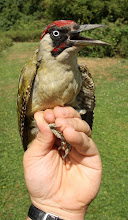
Above: Matt and Steve placing the polystyrene scientifically!

Above: Securing the polystyrene with chicken wire. No chickens were hurt during the making of this!

Above: After Terning the raft back over, we put the gravel back on, attached perches (it's all in the details) and got the anchors on board ready for the journey.

Above: A boat powered by Matt & oar, towed us along by one corner while Steve used a spade to take a square raft into deeper waters! How did we ever get it out there without mishap! I just increased the drag in the water so I could take photographs!

Above: Finally, we anchored it and left. No sooner had we left it than the cormorants found it and started drying their wings in the sun! AKA Steve (left) and Mark (Right).
















